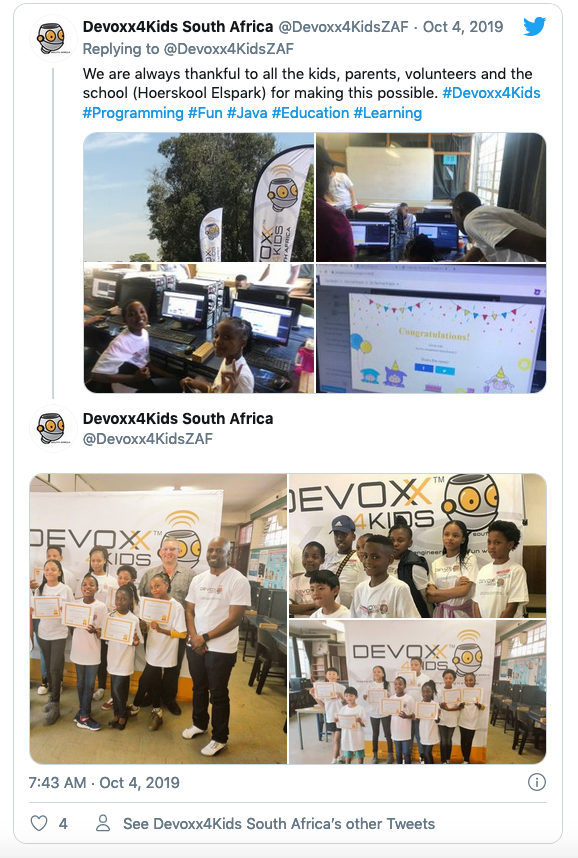I was told that Java was a difficult language to teach to kids, hence why the government curriculum didn’t include programming languages like Java in the school curriculum so before we hosted this event on 28 September 2019, I had a challenge in my hands.
When Progate approached me to use their platform to teach kids programming, I tried it out and found it extremely useful so I couldn’t wait to have this event.
I have had various experiences going to disadvantaged school, trying to entice kids to fall in love with programming and, hopefully, take programming and/or other computer science courses in tertiary education.
With over a decade of software development, predominantly coding in Java, and my love to “giving back to society” Devoxx4Kids South Africa was started in 2017 with a simple goal of enticing kids to fall in love with basic digital skills, such as programming, robotics, etc., with the hope that they can become tech innovators of the future.
As we prepared for the event we thought it would be cool to add a Hello World java program at the back of the kids Devoxx4Kids T-shirts, which we supplied to them for free. The Programme we selected was “Java Study 1 - Getting Started with Java.” from Progate. On the day of the event, after brief introduction to programming on Hour of Code and Code Combat and filling our bellies with free pizza for lunch, the moment of Truth arrived.
We did a small slides into presenting on What is Java and why is it relevant in today’s world (made it short and straight to the point) and then it was off to the actual coding exercises.
Learning Programming: What is Java? (teaching kids the basics of Java - Presentation)
Mind you, unlike Hour of Code & Scratch, where one can create code using blocks, our kids had to physically write code segments on the online editor window and submit the solution online (by clicking the submit button below on the editor window) and see what type of errors they were getting OR seeing the output of their code written on the console window, at the right of the editor window.
Yes, we had feared that kids wouldn’t understand data types. In fact, some kids didn’t know what decimal numbers were but after explaining the basic concepts of numbers it was easy for us to carry on with the exercise. In essence, after the end of our Java session, the kids learnt:
- String object & String concatenation
- Integers
- Double
- Calculations
- Additions
- Multiplications
- Subtractions
- Divisions
- Modulus (yes, tricky but all plausible to teach)
- Variables
- Using Variables
- Updating variables
- Roles of variables
- Explicit type conversion
- Implicit type conversion
And they had the opportunity to write a final Java program using what they have learnt. The kids were put in pairs, essentially practising pair programming. We’ve figured out that when kids are put in pairs they solves problems quicker and they can easily teach their peer on how to get to the solution. We’ve even found that they learn to code by themselves without the need of tutors. In short, in the 2 hours that we allocated for this session, only a 6 year child old finished it in 2 hours. The rest were done within an hour.
Summary
We had a school teacher helping us tutoring the kids during the programming sessions and the feedback we received from him was beyond words. You don’t have to believe our words, we’ve attached the YouTube video highlighting what transpired on the day and the feedback we’ve received.
Should our children be taught Java? (Devoxx4Kids event - 28 September 2019)
Also, it is said that a picture says a thousand words, so here are few of those images of the event:

The kids thoroughly enjoyed it. In fact, some have asked us to teach them to build Android apps, now that they realise that Android apps are built in Java. Who knows, we might start a course just on mobile apps development!
So, what’s the takeaway from this?
- Never box a child. Children have the ability to tackle any challenges, as long as it’s fun, with no perceptions of time and they will eventually figure it out. We were told that Java is not suitable for kids and, yet, a 6 year old managed to write a compilable program in Java.
- There is a huge demand for digital skills. Every child that has participated our events have requested for more of such events and they have even shown interest of introducing this to their friends.
Where can you find us? (Like/Follow us, where possible)
P.S. Seeing that the world has changed due to the pandemic and government lockdown regulations in effect, we’re planning to do online video tutorials on programming topics that kids can learn at their own leisure at home. We’re looking for volunteers that are willing to help us create video content that we can upload on our YouTube channel. Please feel free to reach us on any of the above-mentioned platforms if you’re willing to volunteer your services and we will get back to you ASAP.
We can’t wait to hear from you. Thank you for taking time to read this post.